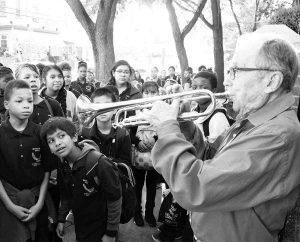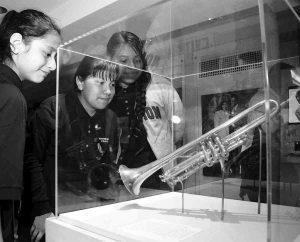
On July 17, groundbreaking was held for an Educational and Visitors Center across the street from the Louis Armstrong House Museum in Corona, Queens, New York. Twenty-three million dollars has been raised to fund construction of the building, which will have a state-of-the-art, multi-media exhibit area; a 72-seat “Jazz Room” where lectures, film screenings and live performances will be held; and a museum store. The entire research collection will be moved over from Queens College and housed on the second floor. The building is expected to be open two years after the start of construction.
The cramped space at the small frame house on 107th Street, Corona has limited the programs and activities that could be held on the property. “We used to host receptions in the basement of the House, but were limited to 40 people,” Museum director Michael Cogswell said. “We had to stop holding them because more people would show up than we could accommodate.”
Archivist Ricky Riccardi points out that having the Educational Center in the immediate proximity will be a game-changer. “Bringing everything together will enable anyone who takes a tour of the House to walk across the street to visit a brand new exhibit gallery, check out the archives, see Louis’s scrapbooks, listen to his tapes and much more.”
When Michael Cogswell came to Queens College in 1991 to create the Louis Armstrong Archives, he found a treasure trove of American jazz history: 72 cartons of memorabilia, including 5,000 photographs, 100 scrapbooks, 650 home recordings, and five gold-plated trumpets. It took him three years to sort through it all before making it available to scholars, music writers and television producers looking for material on the jazz legend.
The Armstrong home was designated a National Historic Landmark in 1977 as well as a New York City landmark, and after a $2 million renovation, it formally opened as a museum in 2003. Following a national search in 2009, Ricky Riccardi, who has a master’s degree in jazz history and research from Rutgers University-Newark and in 2011 authored What a Wonderful World: The Magic of Louis Armstrong’s Later Years, was hired as archivist.
Collections Digitized
Last year, the Museum received a $2.7 million grant from the Robert F. Smith Fund II Foundation to completely digitize the 10 Armstrong research collections, which are currently housed four miles away at Queens College and represent the world’s largest archives for a single jazz musician. This project involved digitizing the contents of over 100 scrapbooks; transferring dozens of rare reel-to-reel tapes, acetate discs and cassettes; and scanning 17,000 photographs, news clippings, sheet music, album jackets, concert programs and letters, all of which will be available for researchers and Armstrong fans on a website by mid-to-late 2018.
Education is a big part of the Museum’s mission. Open daily except on Mondays, it is a popular destination for tourists and school groups, with 40-minute tours conducted by volunteer docents. (There is an admission charge.) Researchers and students who are writing about Armstrong make appointments to meet with Riccardi. Concerts, film screenings and lectures that preserve and promote the cultural legacy of Armstrong are held based on space availability.
Home for the Armstrongs
A year after they were married in 1942, Louis Armstrong and his fourth wife Lucille moved into 34-56 107th Street, Corona in the New York City borough of Queens and lived there for the rest of their lives. With the founding of the Louis Armstrong Educational Foundation in 1969, two years before he passed away at the age of 69 following a series of heart attacks, Louis expressed his wishes “to give back to the world some of the goodness the world gave me.”
It was on this premise that on her passing in 1983 at age 69, Lucille, who had continued to live in the house, willed the home to the City of New York, which then entered into a lease agreement with Queens College to develop the Louis Armstrong House Museum. A grant from the Armstrong Foundation facilitated the Museum’s acquisition of the world’s largest private collection of Armstrong material from Jack Bradley, a noted jazz photographer and friend of the legendary trumpeter.
Unique Features of Home
The Louis Armstrong House Museum is not your typical museum with visitors wandering about wearing earphones and viewing video screens, exhibit cases and static displays. It offers a very personal view of the lifestyle of this jazz icon. Corona is a section of Queens not far from LaGuardia Airport and CITI Field, home of the New York baseball Mets. The house is located on an ordinary, tree-line street in what was a mostly white, middle-class neighborhood when the Armstrongs moved there in 1943.

Armstrong knew the value of kindness and generosity, and that made him a beloved figure in the neighborhood. He didn’t want to show off, so he kept the outside of his house simple. The inside of the house was another story, and it remains much as it was when Armstrong was alive.
The interior is full of artwork, including a portrait of Armstrong painted by fellow legend Tony Bennett. The living room’s treasures included fragile pieces like a vase from France and a statue from Japan, both gifts from dignitaries, but that didn’t stop Armstrong from having neighborhood kids over to watch TV and eat ice cream in the room after giving them music lessons outside on the stoop.
The house has a definite lived-in quality, with worn furniture and rather funky décor such as silver-foil wallpaper. Homemade audio recordings of Louis breathe life into the various rooms. In the dining room, he jokes about Brussels sprouts—not his favorite food. In the wood-paneled office where Armstrong catalogued and stored recordings, many in record sleeves that he decorated with collage art, he is singing “Blueberry Hill.” There is a chairlift to the second floor that Armstrong needed after suffering three heart attacks.
Gold-Plated Fixtures
The bathrooms are glitzy with marble decking, 24-carat gold-plated fixtures, and mirrors lining the walls and ceiling. The kitchen is 1960s state-of-the-art with turquoise-colored cabinets and a custom-made stovetop and double-oven. A small street-level room features rotating exhibits and one of the five Armstrong trumpets found in the house. The garage serves as a gift shop selling among other things, Swiss Kriss, Louis’s laxative of choice, and boxes of red beans and rice, his favorite dish. Outside is an attractive Japanese-inspired garden where the Armstrongs entertained.
“We don’t think that we could be more relaxed and have better neighbors any place else. So we stay put,” Armstrong wrote in an unpublished manuscript found in the home.
“I’ve had the privilege of working here for 18 years as director of the Armstrong House Museum, and I haven’t hit bottom yet,” says Cogswell, who was a professional musician for a dozen years before earning degrees in musicology and library science. “Louis Armstrong is endlessly interesting. He was a trumpet player, vocalist, actor and author. But for all these accomplishments, what inspires me is Louis Armstrong, the person. He was a beautiful guy. He was humble. He was generous. He was a genius.”
As Nicholas Peyton, a fellow trumpeter from New Orleans, summed it all up, “Louis Armstrong is the father of us all, regardless of style or how modern we get. His influence is inescapable. Some of the things he was doing in the ’20s and ’30s, people still haven’t dealt with.”
Visit the Louis Armstrong House online at www.louisarmstronghouse.org.
Further Reading:
Louis Armstrong House Museum in Transition
Michael Cogswell Retires from Directorship of Louis Armstrong House
Louis Armstrong House Museum Names New Director
Louis Armstrong Collection Now Digitized
Louis Armstrong’s Queens Home Now a Shrine to His Genius
Ricky Riccardi’s 20 Essential Louis Armstrong Recordings
Lew Shaw started writing about music as the publicist for the famous Berkshire Music Barn in the 1960s. He joined the West Coast Rag in 1989 and has been a guiding light to this paper through the two name changes since then as we grew to become The Syncopated Times. 47 of his profiles of today's top musicians are collected in Jazz Beat: Notes on Classic Jazz.Volume two, Jazz Beat Encore: More Notes on Classic Jazz contains 43 more! Lew taps his extensive network of connections and friends throughout the traditional jazz world to bring us his Jazz Jottings column every month.






















